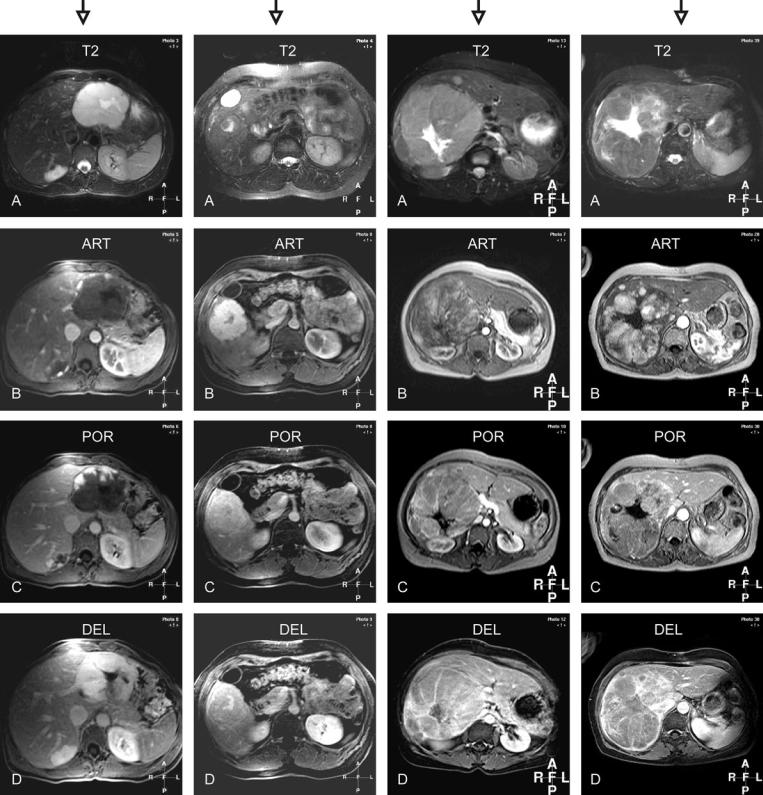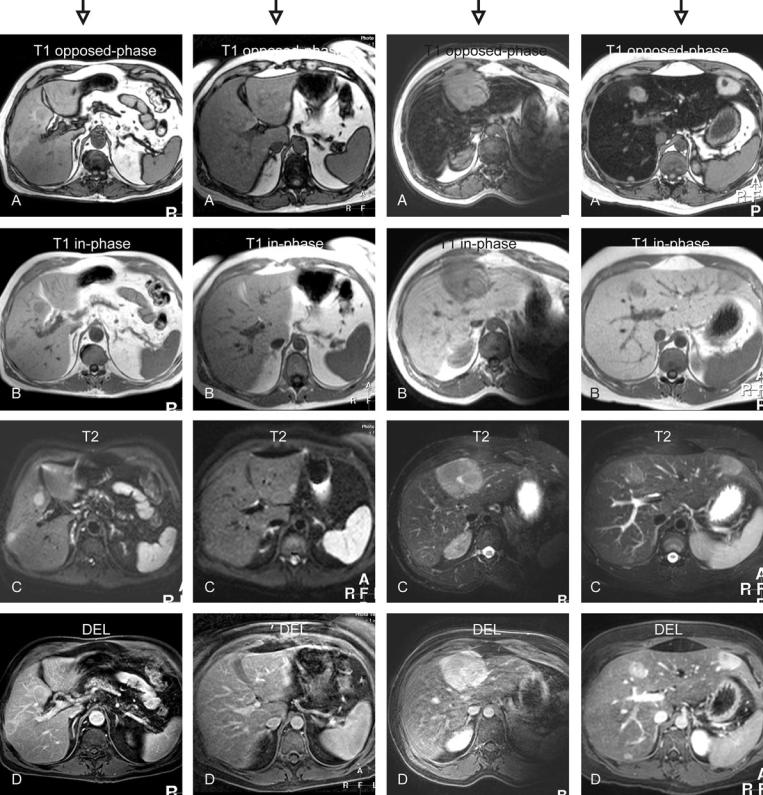
- •Foreword I
- •Foreword II
- •Preface
- •Contents
- •1 Abscesses – Pyogenic Type
- •3 Cyst I – Typical Small
- •4 Cyst II – Typical Large with MR-CT Correlation
- •5 Cyst III – Multiple Small Lesions with MR-CT-US Comparison
- •6 Cyst IV – Adult Polycystic Liver Disease
- •7 Cystadenoma / Cystadenocarcinoma
- •8 Hemangioma I – Typical Small
- •10 Hemangioma III – Typical Giant
- •11 Hemangioma IV – Giant Type with a Large Central Scar
- •13 Hemangioma VI – Multiple with Perilesional Enhancement
- •14 Hemorrhage
- •16 Mucinous Metastasis – Mimicking an Hemangioma
- •17 Colorectal Metastases I – Typical Lesion
- •18 Colorectal Metastases II – Typical Multiple Lesions
- •19 Colorectal Metastases III – Metastasis Versus Cyst
- •20 Colorectal Metastases IV – Metastasis Versus Hemangiomas
- •21 Liver Metastases V – Large, Mucinous, Mimicking a Primary Liver Lesion
- •24 Breast Carcinoma Liver Metastases
- •25 Kahler’s Disease (Multiple Myeloma) Liver Metastases
- •26 Melanoma Liver Metastases I – Focal Type
- •27 Melanoma Liver Metastases II – Diffuse Type
- •28 Neuroendocrine Tumor I – Typical Liver Metastases
- •29 Neuroendocrine Tumor II – Pancreas Tumor Metastases
- •30 Neuroendocrine Tumor III – Gastrinoma Liver Metastases
- •31 Neuroendocrine Tumor IV – Carcinoid Tumor Liver Metastases
- •32 Neuroendocrine Tumor V – Peritoneal Spread
- •34 Renal Cell Carcinoma Liver Metastasis
- •35 Cirrhosis I – Liver Morphology
- •36 Cirrhosis II – Regenerative Nodules and Confluent Fibrosis
- •37 Cirrhosis III – Dysplastic Nodules
- •38 Cirrhosis IV – Dysplastic Nodules – HCC Transition
- •39 Cirrhosis V – Cyst in a Cirrhotic Liver
- •40 Cirrhosis VI – Multiple Cysts in a Cirrhotic Liver
- •41 Cirrhosis VII – Hemangioma in a Cirrhotic Liver
- •42 HCC in Cirrhosis I – Typical Small with Pathologic Correlation
- •43 HCC in Cirrhosis II – Small With and Without a Tumor Capsule
- •44 HCC in Cirrhosis III – Nodule-in-Nodule Appearance
- •45 HCC in Cirrhosis IV – Mosaic Pattern with Pathologic Correlation
- •47 HCC in Cirrhosis VI – Mosaic Pattern with Fatty Infiltration
- •48 HCC in Cirrhosis VII – Large Growing Lesion with Portal Invasion
- •49 HCC in Cirrhosis VIII – Segmental Diffuse with Portal Vein Thrombosis
- •50 HCC in Cirrhosis IX – Multiple Lesions Growing on Follow-up
- •51 HCC in Cirrhosis X – Capsular Retraction and Suspected Diaphragm Invasion
- •52 HCC in Cirrhosis XI – Diffuse Within the Entire Liver with Portal Vein Thrombosis
- •53 HCC in Cirrhosis XII – With Intrahepatic Bile Duct Dilatation
- •54 Focal Nodular Hyperplasia I – Typical with Large Central Scar and Septa
- •55 Focal Nodular Hyperplasia II – Typical with Pathologic Correlation
- •57 Focal Nodular Hyperplasia IV – Multiple FNH Syndrome
- •58 Focal Nodular Hyperplasia V – Fatty FNH with Concurrent Fatty Adenoma
- •59 Focal Nodular Hyperplasia VI – Atypical with T2 Dark Central Scar
- •60 Hepatic Angiomyolipoma – MR-CT Comparison
- •61 Hepatic Lipoma – MR-CT-US Comparison
- •62 Hepatocellular Adenoma I – Typical with Pathologic Correlation
- •63 Hepatocellular Adenoma II – Large Exophytic with Pathologic Correlation
- •64 Hepatocellular Adenoma III – Typical Fat-Containing
- •65 Hepatocellular Adenoma IV – With Large Hemorrhage
- •77 Intrahepatic Cholangiocarcinoma – With Pathologic Correlation
- •78 Telangiectatic Hepatocellular Lesion
- •79 Focal Fatty Infiltration Mimicking Metastases
- •80 Focal Fatty Sparing Mimicking Liver Lesions
- •81 Hemosiderosis – Iron Deposition, Acquired Type
- •82 Hemochromatosis – Severe Type
- •83 Hemochromatosis with Solitary HCC
- •84 Hemochromatosis with Multiple HCC
- •85 Thalassemia with Iron Deposition
- •86 Arterioportal Shunt I – Early Enhancing Lesion in a Cirrhotic Liver
- •89 Budd-Chiari Syndrome II – Gradual Deformation of the Liver
- •90 Budd-Chiari Syndrome III – Nodules Mimicking Malignancy
- •92 Caroli’s Disease I – Intrahepatic with Segmental Changes
- •93 Caroli’s Disease II – Involvement of the Liver and Kidneys
- •95 Choledocholithiasis (Bile Duct Stones)
- •96 Gallbladder Carcinoma I – Versus Gallbladder Wall Edema
- •97 Gallbladder Carcinoma II – Hepatoid Type of Adenocarcinoma
- •98 Hilar Cholangiocarcinoma I – Typical
- •99 Hilar Cholangiocarcinoma II – Intrahepatic Mass
- •100 Hilar Cholangiocarcinoma III – Partially Extrahepatic Tumor
- •101 Hilar Cholangiocarcinoma IV – Metal Stent with Interval Growth
- •102 Hilar Cholangiocarcinoma V – Biliary Dilatation Mimicking Klatskin Tumor at CT
- •103 Primary Sclerosing Cholangitis I – Cholangitis and Segmental Atrophy
- •104 Primary Sclerosing Cholangitis II – With Intrahepatic Cholestasis
- •105 Primary Sclerosing Cholangitis III – With Intrahepatic Stones
- •106 Primary Sclerosing Cholangitis IV – With Biliary Cirrhosis
- •107 Primary Sclerosing Cholangitis V – With Intrahepatic Cholangiocarcinoma
- •108 Primary Sclerosing Cholangitis VI – With Hilar Cholangiocarcinoma
- •109 T2 Bright Liver Lesions
- •110 T1 Bright Liver Lesions
- •111 T2 Bright Central Scar
- •112 Lesions in Fatty Liver
- •113 Appendix I: MR Imaging Technique and Protocol
- •114 Appendix II: Liver Segmental and Vascular Anatomy
- •Subject Index

238 Part VI – Differential Diagnosis
111 T2 Bright Central Scar
Evaluation of the T2-weighted sequence (Figs. 111.1A – 111.4A):
–All lesions have a bright central scar in non-cirrhotic liver. In the first example, the lesion is bright with a brighter central scar. The second example shows only the bright central scar within an almost isointense lesion. The third and fourth examples show large course central scars within large soli-
tary lesions.
Evaluation of the arterial enhancement pattern (Figs. 111.1B – 111.4B):
–In the first example, the lesion shows peripheral nodular enhancement. The second lesion shows very intense homogeneous enhancement with a central scar and septal sparing.
The third and fourth lesions show heterogeneous enhancement.
Evaluation of the portal enhancement pattern (Figs. 111.1C – 111.4C):
–In the first example, the lesion shows more prominent peripheral nodular enhancement. The following lesion becomes almost isointense. The third and fourth lesions show washout
with some capsular enhancement. Evaluation of the delayed enhancement pattern (Figs. 111.1D – 111.4D):
–In the first example, the lesion shows persistent enhancement with central scar sparing. The second lesion became isointense with central scar and septal enhancement.
Based on the following pertinent combination of findings the lesions can be characterized as:
1.Giant hemangioma (T2 bright lesion with a brighter central scar and peripheral nodular enhancement)
2.Focal nodular hyperplasia (isointense on T2; bright wellformed central scar; intense homogeneous arterial enhancement, and enhanced central scar and septa)
3.Hepatocellular carcinoma (large solitary lesion; large coarse central scar; heterogeneous enhancement with washout and capsular enhancement in a non-cirrhotic liver)
4.Hepatocellular carcinoma (idem)

|
|
|
111 T2 Bright Central Scar 239 |
|
|
|
|
T2 bright lesion |
T2 isointense |
T2 slightly bright lesion |
T2 slightly bright lesion |
T2 brighter scar |
T2 slightly brighter scar |
T2 brighter scar |
T2 brighter scar |
Peripheral nodular enhancement |
Homogeneous enhancement |
Heterogeneous enhancement |
Heterogeneous enhancement |
Persistent enhancement |
fades to isointensity |
Washout with capsular |
Washout with capsular |
|
|
enhancement |
enhancement |
Fig. 111.1. Giant and a mid-size |
Fig. 111.2. Focal nodular hyperplasia Fig. 111.3. Hepatocellular carcinoma Fig. 111.4. Hepatocellular carcinoma |
hemangioma |
|

240 Part VI – Differential Diagnosis
112 Lesions in Fatty Liver
Evaluation of the opposedand in-phase T1-weighted sequence (Figs. 112.1A, B – 112.4A, B):
–All livers become dark on opposed-phase images consistent with fatty liver. The lesions in the first example are isointense and surrounded by a rim of fatty sparing. In the third and fourth examples, the liver is severely fatty infiltrated and the
lesions appear bright on opposed-phase images.
Evaluation of the T2-weighted sequences (Figs. 112.1C – 112.4C):
–The lesions appear brighter than the liver. The third lesion contains a bright central scar.
Evaluation of the delayed enhancement pattern (Figs. 112.1D – 112.4D):
–In the first example, the lesions show some persistent perilesional enhancement. The lesions in the third example become almost isointense. The third lesion shows enhanced central scar and the lesion appears brighter within a strongly fatty liver after fat suppression. In the fourth example, the lesions appear brighter within a strongly fatty liver after fat suppression.
Based on the following pertinent combination of findings the lesions can be characterized as:
1.Colorectal carcinoma metastases (T2 bright lesions; persistent perifocal fatty sparing and enhancement)
2.Focal fatty sparing (isointense on in-phase T1; appear bright on fat-suppressed T2 and show faintly more enhancement)
3.Focal nodular hyperplasia (the appearance of this classical FNH is changed due to the severe fatty infiltration of the surrounding liver)
4.Hepatocellular adenoma (strong fatty infiltration of the liver is common in multiple adenomas)

|
|
|
112 Lesions in Fatty Liver 241 |
|
|
|
|
T1 opposed-phase: lesions sur- |
T1 opposed-phase: lesions |
T1 opposed-phase: lesion appears |
T1 opposed-phase: lesions |
rounded by persistent high |
hyperintense |
hyperintense to the dark liver |
appear hyperintense to the |
signal of non-steatosis |
T1 in-phase: no lesions are |
T1 in-phase: lesion is hypointense |
dark liver |
T1 in-phase: hypointense lesions |
visible; liver has normal |
T2: lesion is hyperintense to the |
T1 in-phase: lesions are |
T2: hyperintense lesions |
signal |
liver with a bright central scar |
hypointense |
delayed phase: irregular |
T2: some areas show high signal |
delayed phase: lesion shows |
T2: lesions are slightly |
ring-enhancement |
delayed phase; some lesions |
enhanced central scar |
hyperintense |
|
show faint persistent |
|
delayed phase: lesions show |
|
enhancement |
|
homogeneous enhancement |
Fig. 112.1. Colorectal carcinoma |
Fig. 112.2. Focal fatty sparing |
Fig. 112.3. Focal nodular hyperplasia Fig. 112.4. Hepatocellular adenomas |
metastases |
|
|

Part VII
Appendices |
VII |
